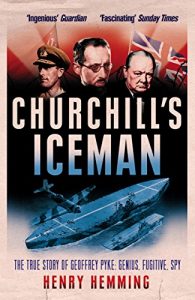There is no reason why you should have heard of Geoffrey Pyke. After his suicide in 1948 he was described as one of the great geniuses of his time, to rank alongside Einstein, yet he remains today, as The Times put it, ‘one of the most original if unrecognised figures’ of the twentieth century.
Inventor, escapee, campaigner, war correspondent, Pyke was an unlikely hero of both world wars and is seen today as the father of the U.S. Special Forces. He changed the landscape of British pre-school education, earned a fortune on the stock market, wrote a bestseller and in 1942 convinced Churchill and Lord Mountbatten to build an aircraft carrier out of reinforced ice. He gave birth to the Mass Observation movement, escaped from a German concentration camp, devised an ingenious plan to get ambulances and microscopes to the Spanish Republicans for free and launched a private attempt to avert the outbreak of the Second World War by sending into Nazi Germany a group of pollsters disguised as golfers. But there was another side to this man. Pyke, it seems, was a man with a secret.
In 2009 MI5 released a mass of material suggesting that Pyke was in fact a senior official in the Soviet Comintern. In 1951 papers relating to Pyke were found in the flat of ‘Cambridge Spy’ Guy Burgess after his defection to Moscow. MI5 had ‘watchers’ follow Pyke through the bombed-out streets of London, his letters were opened and listening devices picked up clues to his real identity. Convinced he was a Soviet agent codenamed ‘Professor P’, MI5 helped to bring his career to an end.
It is only now, more than sixty years after his death, that Geoffrey Pyke's astonishing story can be told in full. Churchill’s Iceman is a many-faceted account of this enigmatic man’s genius, and reveals him as one of the great innovators of the last century.
Inventor, escapee, campaigner, war correspondent, Pyke was an unlikely hero of both world wars and is seen today as the father of the U.S. Special Forces. He changed the landscape of British pre-school education, earned a fortune on the stock market, wrote a bestseller and in 1942 convinced Churchill and Lord Mountbatten to build an aircraft carrier out of reinforced ice. He gave birth to the Mass Observation movement, escaped from a German concentration camp, devised an ingenious plan to get ambulances and microscopes to the Spanish Republicans for free and launched a private attempt to avert the outbreak of the Second World War by sending into Nazi Germany a group of pollsters disguised as golfers. But there was another side to this man. Pyke, it seems, was a man with a secret.
In 2009 MI5 released a mass of material suggesting that Pyke was in fact a senior official in the Soviet Comintern. In 1951 papers relating to Pyke were found in the flat of ‘Cambridge Spy’ Guy Burgess after his defection to Moscow. MI5 had ‘watchers’ follow Pyke through the bombed-out streets of London, his letters were opened and listening devices picked up clues to his real identity. Convinced he was a Soviet agent codenamed ‘Professor P’, MI5 helped to bring his career to an end.
It is only now, more than sixty years after his death, that Geoffrey Pyke's astonishing story can be told in full. Churchill’s Iceman is a many-faceted account of this enigmatic man’s genius, and reveals him as one of the great innovators of the last century.






